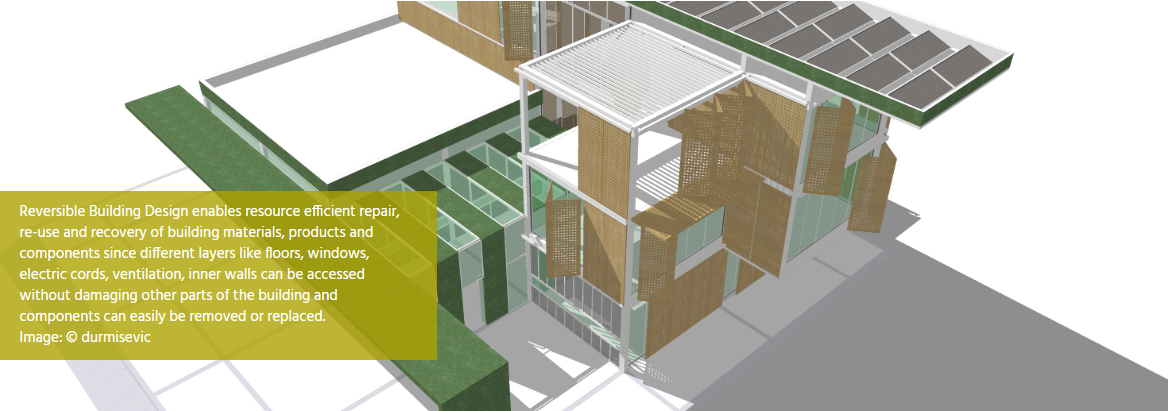Reversible Building Design
Contents |
Definition
Reversible building is the design and construction strategy that has the ambition to realise buildings whose parts follow material loops and facilitate building alterations and support changing user needs.
Emphasising the ability of buildings and their components to return to an earlier state, this strategy strives for high resource productivity
It includes a spatial dimension, in which the building can be efficiently refurbished, as well as a technical dimension, wherein the building’s components can be disassembled and used again or deconstructed and recycled or biodegraded.
Guidelines
To bring the strategy ‘Reversible Building Design’ into practice, various principles, guidelines and techniques have already been proposed. Examples include, the generality of spaces, the adaptability and upgradability of assemblies, the durability and compatibility of building parts and the reversibility of their connections.
Moreover, as many of these design principles facilitate building transformations to changes in needs and requirements, Reversible Building is a synonym for design strategies such as Design for Change. However, whereas Reversible Building Design emphasises the establishment of material loops, Design for Change generally aspires to effective and efficient building transformations.
In BAMB, a Design Protocol for dynamic & circular building will be developed in order to enable different stakeholders in the construction value chain to implement Reversible Design strategies and approaches in construction and refurbishing activities. (For more information visit https://www.bamb2020.eu/topics/reversible-building-design/)
Related terms
Disassemble, Design for Disassembly: the act of removing components from an assembly resulting in pure material flows, facilitating their recycling or biodegradation. Design for Deconstruction is the design and construction strategy that enables the partial or total deconstruction of a building.
Deconstruct, Design for Deconstruction: the act of removing components from an assembly without damage, enabling their reuse. Design for Disassembly is the design and construction strategy that enables the partial or total disassembly of a building.
Design for Change: the design strategy based on the principle that our needs and requirements for the built environment will always change; its aim is to create buildings that support change effectively and efficiently.
Generic, Generality: a building or space that supports changing needs and requirements without physical alterations and the initiation of new material flows. Generality is the degree to which a building or space is generic.
Adaptable, Adaptability: an assembly of building materials that can be altered with a minimum of material flows initiated to support changes in needs and requirements. Adaptability is the degree to which an assembly is adaptable.
Upgradable, Upgradability: an assembly of building materials of which the condition and performance can be improved efficiently. Upgradability is the degree to which an assembly is upgradable.
Compatible, Compatibility: building parts that are designed in accordance to dimensional and possibly other standards, to ensure they are interchangeable or easy to combine.
Reversible connections: connections, i.e. physical relationship between building parts, that can be undone without damaging the parts they connect, e.g. bolts, screws, or soft lime mortars.
Circular building: a building designed according to Reversible Building principles.
Circular building products, ~ parts: building products or building parts designed according to Reversible Building principles.
References
Durmisevic E. (2006). Transformable building structures: design for disassembly as a way to introduce sustainable engineering to building design and construction (doctoral thesis). TUDelft.
Galle W. and Herthogs P. (2015). Veranderingsgericht bouwen: gemeenschappelijke taal. Mechelen: Openbare Vlaamse Afvalstoffen Maatschappij OVAM.
Oxford Advanced Learner’s Dictionary (2017). Accessed March 2017 via www.oxfordlearnersdictionaries.com. Oxford: Oxford University Press.
--BAMB - Buildings As Material Banks 09:41, 15 Aug 2018 (BST)
Featured articles and news
Infrastructure that connect the physical and digital domains.
Harnessing robotics and AI in challenging environments
The key to nuclear decommissioning and fusion engineering.
BSRIA announces Lisa Ashworth as new CEO
Tasked with furthering BSRIA’s impressive growth ambitions.
Public buildings get half a million energy efficiency boost
£557 million to switch to cleaner heating and save on energy.
CIOB launches pre-election manifesto
Outlining potential future policies for the next government.
Grenfell Tower Inquiry announcement
Phase 2 hearings come to a close and the final report due in September.
Progress from Parts L, F and O: A whitepaper, one year on.
A replicated study to understand the opinion of practitioners.
ECA announces new president 2024
Electrical engineer and business leader Stuart Smith.
A distinct type of countryside that should be celebrated.
Should Part O be extended to existing buildings?
EAC brands heatwave adaptation a missed opportunity.
Definition of Statutory in workplace and facilities management
Established by IWFM, BESA, CIBSE and BSRIA.
Tackling the transition from traditional heating systems
59% lack the necessary information and confidence to switch.
The general election and the construction industry
As PM, Rishi Sunak announces July 4 date for an election.
Eco apprenticeships continue help grow green workforce
A year after being recognised at the King's coronation.
Permitted development rights for agricultural buildings
The changes coming into effect as of May 21, 2024.























